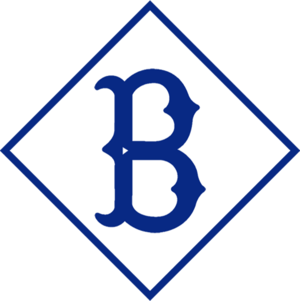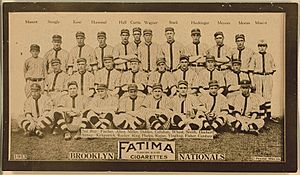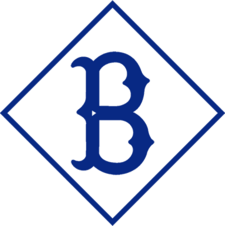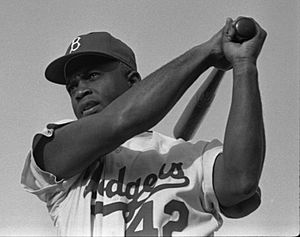Brooklyn Dodgers facts for kids
Quick facts for kids Brooklyn Dodgers |
|
|---|---|

Logo of the Brooklyn Dodgers/Superbas from 1910 through 1913
|
|
| Information | |
| League | National League (1890–1957) |
| Ballpark | Ebbets Field (1913–1957) |
| Year established | 1883 |
| Year folded | 1957 (moved to Los Angeles, California in 1958) |
| Nickname(s) | Dem Bums |
| National League pennant | 12 (1890, 1899, 1900, 1916, 1920, 1941, 1947, 1949, 1952, 1953, 1955,1956) |
| World Series championships | 1 (1955) |
| Former name(s) |
|
| Former league(s) | American Association (1884–1889) |
| Former ballparks |
|
| Colors | Dodger blue, white, red |
| Manager | See list |
The Brooklyn Dodgers were a famous Major League Baseball team. They started in 1883 as the Brooklyn Grays. In 1884, they joined the American Association. Then, in 1890, they became part of the National League. The team stayed in Brooklyn, New York, until 1957. After that, the club moved to Los Angeles, California. Today, they are known as the Los Angeles Dodgers. At the same time, their old rivals, the New York Giants, also moved to San Francisco.
The team's name came from how good Brooklyn people were at avoiding the city's trolley streetcars. "Dodgers" is a shorter version of their original name, the Brooklyn Trolley Dodgers. The Dodgers played in several stadiums. These included two called Washington Park and Eastern Park. In 1912, they moved to Ebbets Field in Crown Heights. The team is also famous for signing Jackie Robinson in 1947. He was the first black player in modern Major League Baseball.
Contents
How the Dodgers Team Started
The team we know as the Dodgers began in 1883. A real estate expert and baseball fan named Charles Byrne started it. He worked with his brother-in-law Joseph Doyle and casino owner Ferdinand Abell. Byrne built a baseball field called Washington Park. It was named after George Washington.
Reporters called the team the "Grays" because of their uniforms. In their first season, they played in a smaller league called the Inter-State Association. Doyle was the first manager. They won their league title that year. In 1884, the Grays were invited to join the American Association. This was a bigger professional league.
In 1889, the Brooklyn team won the American Association championship. Then, they moved to the older National League in 1890. They won the National League Championship in 1890 too! This made them the only team to win championships in two different major leagues in a row. They lost the 1889 championship to the New York Giants. They tied the 1890 championship with Louisville.
In 1899, many star players from the old Baltimore Orioles joined the Brooklyn team. This happened because Harry Von der Horst owned parts of both teams. The famous Orioles manager Ned Hanlon also came to Brooklyn. The team's main owner was Charles Ebbets. The press started calling this new team the Brooklyn Superbas. They won the National League championship in 1899 and again in 1900.
Why "Dodgers"? The Team's Many Names
The name Brooklyn Trolley Dodgers was first used for the team in 1895. A newspaper in September 1895 said that "Trolley Dodgers" was a new name fans gave the Brooklyn club. In 1895, Brooklyn played at Eastern Park.
Some people mistakenly thought the name "Trolley Dodgers" meant people avoiding fast cars near Eastern Park. However, Eastern Park didn't have trolley lines right next to it. The name "Trolley Dodgers" was about the general danger of trolley cars in Brooklyn. In 1892, trolleys switched from horse-power to electricity. This made them much faster and more dangerous. The name was later shortened to Brooklyn Dodgers.
The team had many other nicknames over the years. These included the Atlantics (1884), Bridegrooms or Grooms (1888–1898), Ward's Wonders, the Superbas (1899–1910), and the Robins (1914–1931). Fans and sports writers used these names. But the team's official name was the Brooklyn Base Ball Club.
The "Trolley Dodgers" nickname was used often, along with others. The team didn't officially use "Dodgers" until 1916. That year, the name was printed on World Series programs. The word "Dodgers" first appeared on team jerseys in 1932. By 1933, both home and away jerseys had "Dodgers" on them.
Newspaper articles show how these names were used. A New York Times article from 1916 called them "Dodgers" at first. But then it also called them "Superbas" in the same story. Most baseball historians now call the 1916 team the Robins. But the Brooklyn Daily Eagle newspaper still used "Superbas" in its game results that season.
The Dodgers' Big Rivalry with the Giants
The Dodgers and the Giants have had a huge rivalry for over 100 years. It started in the 1889 World Series, when both teams were in New York. Brooklyn and New York were separate cities until 1898. Then, they became neighboring parts of the bigger New York City. When both teams moved to California after the 1957 season, their rivalry moved too. Los Angeles and San Francisco have always been rivals.
The "Daffiness Boys" Era
Manager Wilbert Robinson, nicknamed "Uncle Robbie," made the Brooklyn team good again. His "Brooklyn Robins" played in the 1916 and 1920 World Series. They lost both, but they were a strong team for many seasons. When Robinson became team president in 1925, his focus on the field changed. The teams of the late 1920s were called the "Daffiness Boys." This was because they made many funny errors.
Outfielder Babe Herman was a great hitter and also known for his silly plays. One famous play happened when three Dodgers players – Dazzy Vance, Chick Fewster, and Herman – all ended up on third base at the same time! People often joke about Herman "tripling into a triple play." But only two players were out, and Herman got a double. This led to a popular joke:
- "The Dodgers have three men on base!"
- "Oh, yeah? Which base?"
After Robinson stopped being president, he went back to managing. The team's performance got better. When Robinson retired in 1931, Max Carey became the new manager. Some people thought the team should be renamed the "Brooklyn Canaries" after Carey. But the name "Brooklyn Dodgers" came back for good after Robinson left.
During this time, a sports cartoonist named Willard Mullin gave the team a new nickname: "Dem Bums". He heard his cab driver ask, "So how did those bums do today?" Mullin then drew a funny cartoon of a circus clown to represent the Dodgers. This image and nickname became very popular.
A highlight of this era came in 1934. Giants player/manager Bill Terry joked, "Is Brooklyn still in the league?" The Dodgers, managed by Casey Stengel, were determined to prove him wrong. At the end of the season, the Giants were tied with the St. Louis Cardinals for the championship. The Giants had to play the Dodgers. Stengel led his "Bums" to the Polo Grounds. They beat the Giants twice, knocking them out of the race!
In 1938, Leland "Larry" MacPhail became the Dodgers' general manager. He brought night games to Major League Baseball in Brooklyn. He also made Ebbets Field better. MacPhail brought Red Barber to Brooklyn as the Dodgers' main announcer in 1939. MacPhail left the Dodgers in 1942 to join the military in World War II.
The first Major League Baseball game shown on TV was Brooklyn's 6–1 win over Cincinnati at Ebbets Field on August 26, 1939. The Dodgers also introduced Batting helmets to Major League Baseball in 1941.
Breaking the Color Barrier in Baseball
For most of the early 1900s, no Major League Baseball team had black players. There were separate Negro leagues for black players. But most of these players never got to show their skills to a national audience. Jackie Robinson changed this. He became the first African-American to play Major League baseball in the 20th century. His first game was on April 15, 1947, with the Brooklyn Dodgers. This happened mainly because of General Manager Branch Rickey.
Rickey was a very religious man. He wanted to do what was right, but he also thought about business. Rickey saw his chance after Commissioner Kenesaw Mountain Landis died in 1944. Landis had strongly supported keeping baseball segregated.
Rickey chose Robinson not just for his amazing baseball skills. He also picked Robinson for his strong character. Robinson had gone to UCLA and was a captain in the U.S. Army. Rickey knew Robinson would face boos and insults. He needed someone tough enough to handle it without fighting back.
Because Robinson joined the team, the Dodgers had to change their spring training location. Before 1946, they trained in Jacksonville, Florida. But the city's stadium refused to host a game with the Montreal Royals. This was the Dodgers’ minor league team, and Robinson was on its roster. The city refused because of segregation laws. Another nearby city, Sanford, also said no. Finally, City Island Ballpark in Daytona Beach agreed to host the game with Robinson.
In 1947, the team went to Havana, Cuba, for spring training. Robinson was now on the main Dodgers team. The Dodgers later built their own training site, Dodgertown, in Vero Beach. They trained there from 1948 to 2008. Daytona Beach renamed City Island Ballpark to Jackie Robinson Ballpark in his honor.
Robinson's arrival was a big moment for civil rights in America. Professional football had started integrating in 1946. The Negro leagues slowly ended after this. Robinson was an amazing player. He was a fast runner and brought a lot of energy to the team. He won the first Rookie of the Year award. This award is now named the Jackie Robinson award.
The Dodgers were willing to integrate when other teams weren't. This helped them succeed from 1947 to 1956. They won six championships in those 10 years. This was thanks to Robinson, three-time MVP Roy Campanella, Cy Young Award winner Don Newcombe, Jim Gilliam, and Joe Black. Robinson later became the first African-American elected to the Baseball Hall of Fame in 1962.
Finally, "Next Year" Arrives!
After some tough years in the 1920s and 1930s, the Dodgers became a top team again. This was thanks to general managers Larry MacPhail and Branch Rickey. The team had stars like Jackie Robinson, Pee Wee Reese, and Gil Hodges. In the outfield were Duke Snider and Carl Furillo. Roy Campanella was behind the plate. Pitchers included Don Newcombe, Carl Erskine, and Preacher Roe.
The Dodgers won championships in 1941, 1947, 1949, 1952, and 1953. But each time, they lost to the New York Yankees in the World Series. Fans would get excited every year, only to be disappointed. So, "Wait ’til next year!" became their unofficial slogan.
In 1951, the Dodgers had one of the biggest collapses in baseball history. On August 11, 1951, Brooklyn was leading the National League by a huge 13½ games over their rivals, the Giants. The Dodgers played okay for the rest of the season. But the Giants went on an amazing winning streak! They won 37 of their last 44 games, including their last seven in a row. At the end of the season, the Dodgers and Giants were tied. This forced a three-game playoff for the championship.
The Giants won Game 1. The Dodgers won Game 2 with a shutout. It all came down to the final game. Brooklyn seemed to have the championship won, leading 4–2 in the bottom of the ninth inning. But Giants outfielder Bobby Thomson hit a stunning three-run walk-off home run. He hit it off Dodgers pitcher Ralph Branca. This won the NL Championship for New York. To this day, Thomson's home run is known as the Shot Heard 'Round The World.
In 1955, the Dodgers' core players were getting older. But "next year" finally arrived! The famous "Boys of Summer" beat the "Bronx Bombers" (the Yankees) in seven games. Young left-handed pitcher Johnny Podres was key. He won two Series games, including the final Game 7. A huge play in Game 7 was a double play. Left fielder Sandy Amorós caught Yogi Berra's long fly ball. He then threw to shortstop Pee Wee Reese, who threw to first baseman Gil Hodges. They doubled up a surprised Gil McDougald. This saved the Dodgers' lead. The Dodgers won 2–0.
The Dodgers lost the World Series to the Yankees in 1956. Yankees pitcher Don Larsen even pitched the only World Series perfect game in baseball history. But it didn't seem to matter much. Brooklyn fans had their memory of winning. This victory was even remembered decades later in the Billy Joel song "We Didn't Start the Fire".
Moving to California
Real estate businessman Walter O'Malley became the main owner of the Dodgers in 1950. He wanted to buy new land in Brooklyn for a better ballpark. Ebbets Field was old and hard to get to. Even when the Dodgers were winning, they couldn't always fill the stadium.
New York City official Robert Moses wanted O'Malley to use a site in Flushing Meadows, Queens. This is where Shea Stadium (home of the future New York Mets) was later built. Moses wanted a city-built park. But O'Malley wanted to own his own ballpark. When O'Malley realized he couldn't buy suitable land in Brooklyn, he thought about moving the team.
O'Malley wanted Robert Moses to help him buy land in downtown Brooklyn at a lower price. Moses refused. He told O'Malley to buy the land with his own money if he wanted it so badly.
Meanwhile, long-distance airplane travel had become common after World War II. Baseball teams could now travel farther. This made it possible to have teams as far west as California.
In 1956, officials from Los Angeles went to the 1956 World Series. They wanted to convince a team to move there. They weren't even thinking of the Dodgers at first. But O'Malley heard about it. He was looking for options if New York politicians wouldn't let him build his stadium. Los Angeles offered him what New York didn't: a chance to buy land for a ballpark and own it. This would give him control over all the money it made.
The National League didn't want the Dodgers to move alone. They wanted a second team to move west too, because of travel costs. Giants owner Horace Stoneham was also having trouble finding a new stadium for his team, the Polo Grounds. Stoneham was thinking of moving the Giants to Minneapolis. But he was convinced to move them to San Francisco instead. This meant the Dodgers would have a rival closer than St. Louis. So, the two rival teams, the Dodgers and Giants, moved to the West Coast together after the 1957 season.
The Brooklyn Dodgers played their last game at Ebbets Field on September 24, 1957. The Dodgers won 2–0 against the Pittsburgh Pirates.
On April 18, 1958, the Los Angeles Dodgers played their first game in L.A. They beat the newly moved and renamed San Francisco Giants, 6–5. Over 78,000 fans watched at the Los Angeles Memorial Coliseum. Catcher Roy Campanella was partly paralyzed in a car accident in January 1958. He was never able to play for the Dodgers in Los Angeles.
A 2007 HBO film, Brooklyn Dodgers: The Ghosts of Flatbush, is a documentary about the Dodgers' history. It tells a story about how much Brooklyn Dodger fans hated O'Malley after the move. They joked, "If you had a gun with only two bullets and were in a room with Hitler, Stalin, and O'Malley, who would you shoot? The answer: O'Malley, twice!"
Images for kids
See also
 In Spanish: Brooklyn Dodgers para niños
In Spanish: Brooklyn Dodgers para niños





